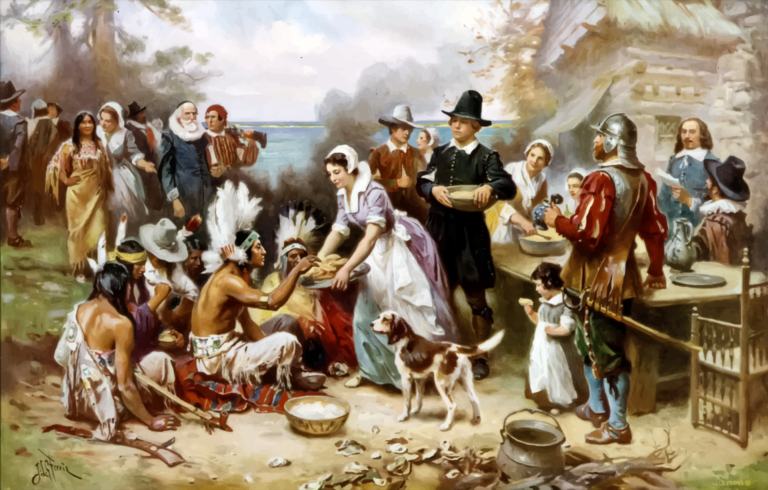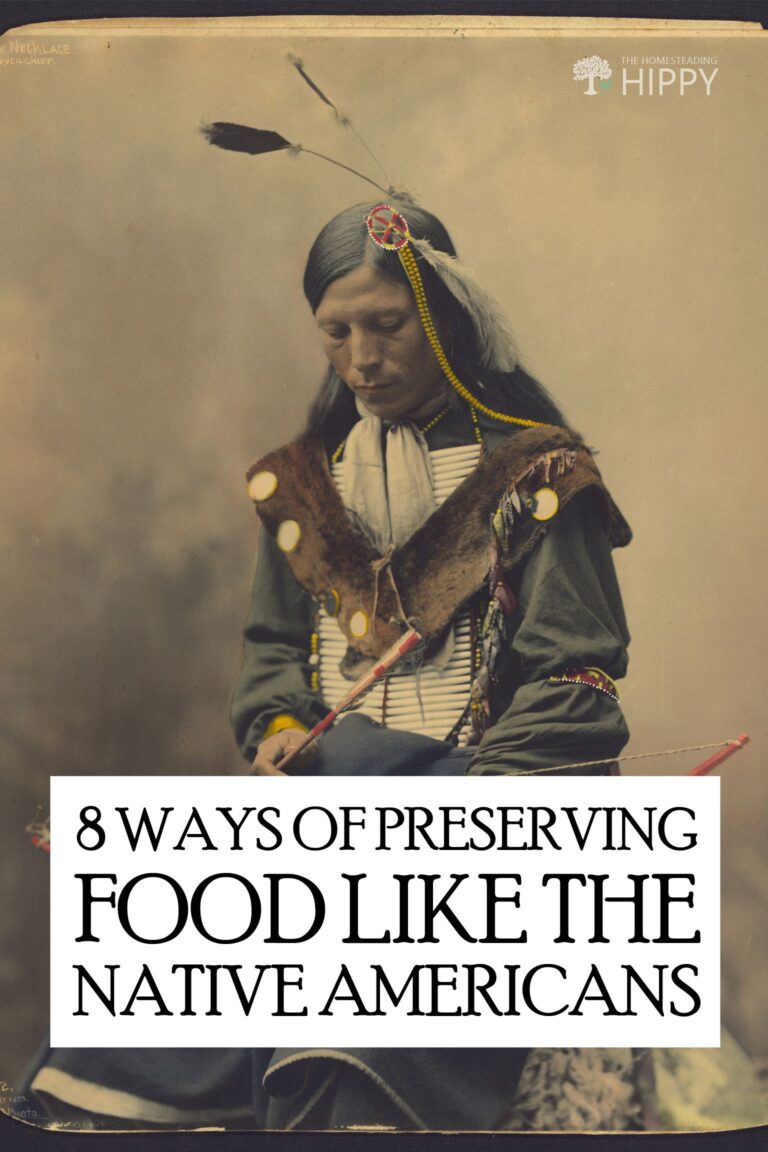Native Americans – they were the ultimate survivalists. Their lifestyle was such that they made everything that they needed. They were farmers, extraordinarily efficient hunters, and experienced foragers.

By October and early November every year, they had harvested most of their cultivated crops. However, the hardest part was preserving the food for the coming winter months.
This task was especially difficult for the Nomadic tribes who needed to pack all their belongings and supplies for quick and convenient transport.
These tribes would move every few weeks or months, depending on the size of the tribe. As a result, their supply of food needed to be as small and as light as possible.
Although they preferred to eat their meat from hunting, when it was freshest, this was not always possible. A single buffalo could supply them with 200 pounds of meat.
This was far too much for most tribes to eat at one time. Without preserving the remainder of the meat, most of it would be wasted.
And as you likely know, wasting valuable resources was against the Native American’s belief system.
Native Americans, in general, were able to live well on the land while also respecting and preserving the available natural resources.
They learned to live in harmony with nature, preventing the natural resources in a particular area from being exhausted while still extracting what they needed to survive.
As a part of their lifestyle and belief system, they developed food preservation techniques that were then refined and handed down over the generations.
Many of these techniques are still being used today not only in the Americas but also around the rest of the world.
Food Typically Preserved by Native Americans
Native Americans were adept at growing various crops, many of which were developed and refined from wild plants. They were also very skilled at identifying what wild-growing produce was good to eat.
During certain parts of the year, there was an abundance of crops and natural vegetation to support the entire community without any need for preservation.
However, to ensure that this supply lasted through an unproductive season, they had to come up with techniques for preservation.
Hunting was a very important part of the Native American lifestyle. This provided the tribes with a plentiful supply of food that could also be preserved.
The typical foods that would have been preserved by the Native Americans are similar to the ones that are often preserved on today’s homesteads:
- Berries, fruit, nuts, corn, squash
- Roots, onions, wild potatoes
- Fish
- Birds
- Animals (including buffalo, elk, and deer along with more unusual meats like porcupines, and snakes)
This list above is not exhaustive – there are many others that they were able to preserve. The foods varied depending on where the tribes were located.
Preservation Techniques
Native Americans used several techniques to preserve their food, which enabled them to survive during winter months and fallow times of the year.
Techniques used by this ancient race were tried and tested and are relevant, viable, and still in use today. Perhaps we should all learn to preserve food like the Native Americans!
If you’re interested in learning how to preserve food like the Native Americans, give these techniques a try.
Drying
Drying food was one of the most popular preservation methods. Microorganisms and enzymes react and thrive on fresh food and as a result, cause it to spoil prematurely.
Therefore, any process that reduces the moisture content in food will prevent the microbial organisms from causing decay.
Reducing the moisture content also has the advantage that it concentrates the nutrients within the food while also reducing its weight.
Today when we dry food, we often use a dehydrator or an oven. Traditionally, however, the power of the sun or fire was used. On some occasions, both would have been used in tandem to dry food quickly and efficiently.
The principle of using the heat from the sun or fire was universal amongst most tribes. However, in different areas of the country, they used slightly different preparation techniques.
An example of these different techniques can be seen when we compare how the Southwestern tribes, such as the Hopi, dried corn. The Hopi could dry the intact corn on the cob before storing it.
The corn cob was laid out on flat rocks, hides, or grass mats to sun-dry.
This activity was generally organized by the elderly and children. They would regularly turn the corn to ensure even drying and keep insects away.
Constant supervision kept birds and other scavengers away as well. As you can see, it was quite a time-consuming task.
Other tribes would remove the corn from the cob before drying and storing it., with preservation techniques varying.
Food such as beans could be left on the plant to dry in the sun before harvesting while other foods were fully harvested before they could be allowed to dry.
Tribes that lived in different locations had differing techniques of gathering and harvesting vegetables, but usually, the method of drying was the same – dry the vegetables in the sun or close to a fire to reduce the water content.
Most tribes would cut the vegetables into strips that could be flattened using a rock or bone.
Smaller pieces dried out quicker, with Pawnee and Wichita tribes often drying small, narrow y strips of pumpkin, that could be used to weave into mats. These were easier to store and facilitated better portion control.
Most of us are familiar with jerky, which is basically slices of dried meat. Few of us are aware that the Native Americans also made and enjoyed jerky. The Chickasaw called it called “nipi’ Shila’”, which unsurprisingly, means dried meat.
The meat from most hunted animals was cut into thin strips before hanging on drying racks made from branches. Alternatively, they were spread onto rocks for the sun to dry. In some cases, the rocks were heated in a fire to speed the process up.
Watching over the meat was another task reserved for children and the elderly. They would fan the meat to keep away the flies and other insects.
Many other seasonal foods that were available in the tribe’s location were dried for use out of season. For example:
- Dandelions
- Sunflower seeds
- Acorns
- Mustard seeds
- Wild rice
- Herbs such as sage

Smoking Cured Food
Smoking was also a popular method that was used by the Native Americans to preserve food. It was not unusual for both the sun and smoking to be used in combination with each other.
Typically, this combined process would only be used on meat and fish. Fruit, vegetables, and other foods could be dried in the sun only.
Meat or fish were cut into strips that could be hung on racks and placed over a fire or in smoke rooms. Smaller fish would be cleaned and gutted but left whole for this process.
Smoke rooms were either rough wooden structures or tip is that were used exclusively for this task.
Smoking was far more labor-intensive than using the sun to dry the food. The meat would be in the smokehouse with a slow smoldering fire for anywhere between a few hours to several days. The fire would need to be maintained for the entire time.
Time spent smoking meat was worthwhile, though, since smoked meat was far better in terms of longevity than sun-dried alone. The smoke would dry the food whilst depositing oils and particles from the smoke onto the meat or fish.
The oils and particles would help to create a barrier between the air and the meat whilst adding a distinctive taste. The taste would vary by using different woods.
Salt as a Preserver
Salt can be used to dehydrate foods, and to also to inhibit bacteria growth.
Two methods are used to dehydrate food: rubbing salt onto the surface of the meat or placing strips of meat in a saltwater solution. These methods are referred to, respectively, as dry and wet curing.
For dry curing, the meat is completely coated with salt before storing.
Wet curing involves submerging the food in a concentrated salt water solution, where it is left for approximately four weeks.
The advantage of wet curing is that herbs, spices, and sometimes sugar can be added to the solution to create different tastes.
The downside is that the food must be removed every week so that the saltwater solution can be stirred before the food is placed back.
Nipi hapayimma, a phrase that translates to “salty meat”, was and still is a popular method of preserving food among the Chickasaw community.
The process of curing was, however, not a widespread method. Tribes that lived farther inland would not have been able to amass the large quantities of salt necessary for this task.
Natural Freezing in Cold Areas
For tribes that had access to high mountains or whose climates provided regular snow, it was also possible to freeze food – even without commercial refrigeration like we have today.
The meat would be wrapped in animal skins to protect it from the severe cold which has the potential to damage the meat via direct contact. The bundles were then buried in the snow.
It was a simple task to remove the bundles and defrost the meat in the sun before eating.
However, not all types of food are suitable for freezing and the weather could be fickle and uncontrollable, as it still can be.
Freezing food was, therefore, often too unpredictable to rely on solely.
Fermentation
Fermentation was not as widespread as dehydration, however, it was another technique that was used by some tribes. It is not entirely clear if fermentation was a method of preserving food or if it was a method of preparing dishes that were widely enjoyed.
The Cherokee tribe prepared a famous bread in this way, although today we would perhaps refer to it as a dumpling due to its texture.
Corn was cooked to remove the husks before being ground and mixed with cooked beans and the hot liquor formed via the process of fermentation.
The dough was then formed into a patty which was wrapped in corn leaves and left to ferment for a few weeks.
There is evidence that some fish and meat items were also fermented. Similar to the breads, they would have been eaten when ready, rather than storing for the long term.
Chippewa and Cree tribes took the half-digested food from a caribou’s stomach and mixed it with smaller tender cooked meat trimmings and blood.
This mixture was put back into the caribou’s stomach before hanging in the heat and smoke of fire for several days.
The drying or smoking process would preserve food for a year so that it could be eaten as needed. Fermented products were, however, eaten soon after the process was completed.
Natural Cooling Root Cellars
Many of us are familiar with root cellars, and perhaps even use them as a method of storing and preserving our crops for later use. This is not, however, a modern invention but has been in use for thousands of years.
The Native Americans were no strangers to the use of this technique. They did, not use a separate room for a root cellar but instead buried food in clay storage containers. The containers were lined with straw or bark to prevent rodents from stealing the stash of food.
Many of the tribes were proficient gatherers. This gave them access to a large range of nuts such as cashews, peanuts, hickory nuts, and pine nuts.
Fruit including blueberries, wild plumbs, chokeberries, strawberries, and raspberries.
They also used a wide range of beans and greens, both of which could also be stored in this kind of old-fashioned root cellar system.
Burying clay containers allowed access to the natural cooling temperature of the earth. This could be used to preserve the foodstuff and keep it edible for a considerable period of time.
Root cellars were also perfect for storing food that had been dried or smoked. The Lenape would dig pits and clean them with fire to kill bugs and bacteria. They would use these pits that were lined with clay and bark or reed mats many times over.
Pemmican – the Fast Food of the Native Tribes
Many tribes, including the Lakota Chippewa and the Cree, used Pemmican as a method of preserving food. When made properly, most pemmican will last for at least a year.
The method used by the various tribes to prepare pemmican was the same that we rely on today and was shared by most tribes – however, the recipe used would vary according to individual tribes.
Pemmican is dried meat that has been pulverized, added to crushed dried berries, and held together by rendered fat.
The meat and berries used for this recipe were whatever was plentiful at the time of making. The meat could be bison, moose, or elk and the fruit could be chokeberries, blueberries, or cranberries.
However, the combination of products that can be used is endless.
This mix was normally made into hand-sized pieces that could easily be placed into rawhide bags for easy storage.
Pemmican had lots of benefits. It was easy to store and transport. It was also a calorie-dense food rich in nutrients that was ideal for eating when other fresh food was in poor supply.
A few balls of this preserved product placed in boiling water with some fresh vegetables made a quick wholesome meal. It was also perfect for hunting parties who needed to eat on the go in order to maintain their strength.
Rendering Fat
Hunting parties, having killed a large animal such as a buffalo or a bison, would have upwards of 200 pounds of meat and fat.
As much of the animal as possible needed to be preserved for later consumption. The fat from an animal is dense in calories, making it an important asset. The fat, however, deteriorates and goes rancid very quickly.
To preserve this asset, the fat would be cooked over low heat with a small amount of water for approximately two or three hours.
The fat, when cooled, could be cut into manageable single portion sizes before wrapping.
Provided that the rendered fat was kept out of the sun and relatively cool, it would last for about a year.
We have seen that rendered fat was used to create pemmican. However, it was also used to add taste to whatever was being cooked, making it a versatile ingredient.
The taste provided by this preserved fat did depend upon the animal that it came from.
I am told that beaver tail does provide a very tasty fat that can be used in many ways.
Summary
We have seen how the Native Americans lived a life that respected the natural resources of the land in which they lived. Tribes lived in slightly different ways; however, their main preoccupation was to provide sufficient food.
There were times when food was plentiful. It was during these plentiful periods that time was spent preserving food to ensure that they had a constant supply.
We have seen that 8 techniques were used to preserve different food types. Tribes living in different areas of the nation would use some or all of these techniques but often had their individual variations.
Although these techniques were developed and used some time ago it is still possible for us to preserve food just like the Native Americans.
Many people who live in a remote or homestead existence still have the same basic problem. How to make food from an abundant time last while fresh food is short.
Many people use at least some of these basic techniques although their application might be somewhat different. We might use glass to cover our sun-dried products or use a BBQ to smoke meat. The result is the same.
What about the Fermentation I hear you ask, that doesn’t sound like something we would try. However, popular products such as Sauerkraut use a fermentation process.


Three years ago, I bought an off-grid Cortijo in a small valley in the Andalucian mountains. Although, perhaps the lifestyle is in my genes as my grandfather and his four brothers were Homesteaders in Alberta Canada in the 1900s.
The mountains of Spain are a difficult place to grow many of the flowers that I was used to in the UK. However, veggies grow well year-round. Peppers, tomatoes, potatoes, lettuce, cucumber, melons, and chard all fare well in the Mediterranean climate. Almond trees provide me with a cash crop of around 1 ton while still retaining some to make almond milk and flour.
Meet the rest of the Homesteading Hippy team here.

Your over use of the term Native American” really made my head spin, why not just call them Indians?
It seems you have placed these people on a pedestal but truth is they misused resources like everyone else, there is nothing innocent or magical about them.
early native American Indians would usually not have enough to last the winters. winter was known as the hungry time. very long term preservation was not an issue with most tribes as they did not have the resources. some in the southwest built grain storage, but most did not.